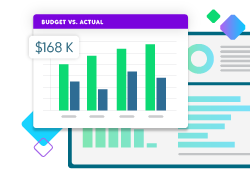4 Financial Metrics to Increase Transparency for Your Nonprofit

Every day, you and your donors are inundated with thousands of pieces of news and bits of information. It can be tricky to figure out what’s real and who you can trust. As leaders in the nonprofit and social impact space, it’s so important for you to project a clear sense of trust into the world. You want your donors to trust your work, your impact, your stewardship of resources, and your connection to the community, and stand out in a sea of information.
Building this trust with your community and stakeholders is only possible through radical transparency—sharing information into the world that showcases who you are as an organization, your strengths, and your areas of opportunity. It is only through this radical transparency that you will be able to grow, innovate, and amplify your impact on the world.
Impact of Transparency in Nonprofits
Studies show that organizations that provided better and more information to stakeholders raised substantially more money in subsequent years than organizations that didn’t share information with stakeholders. More specifically, nonprofits that went from not transparent at all to fully transparent via their Guidestar profile raised 53% more in contributions in the following year. And nonprofits that just upgraded their Guidestar rating one unit by being just a little bit more transparent still raised 26% more the following year.
Why Aren’t Nonprofits More Transparent?
But only 16% of nonprofits in the Guidestar database of 14,000 organizations actually take the time to actively be more transparent. If the data is proven, why in the world isn’t everyone doing this?
First of all, let’s break down the drivers of nonprofit transparency to understand why there’s such a gap. This study concluded that the following factors were strong determinants into the organization’s level of transparency:
- Strength of organization’s governance and board: If the nonprofit has a large, active board that meets all the standard measures of good governance (check out the governance section of the 990 for more info), they’re more likely to be transparent with their financials.
- Performance of the organization: If the organization has strong growth and positive financial metrics, they will be more likely to share this information. On the flip side, poor-performing organizations are more hesitant to share for fear of increased scrutiny.
- Professionalism of the staff: If the nonprofit has a paid, full-time, professional staff, they are likely to have the capacity and expertise to be more transparent, compared to organizations with smaller, volunteer staff.
- Organization’s reliance on contributions: If an organization relies heavily on contributions from the general public—as opposed to program service fees or large government contracts—they are more likely to respond to donor requests for transparency.
- State regulation environment: If the nonprofit resides in a state that requires an audit or other forms of transparency and disclosure, the organization will be more transparent in order to comply.
But not all nonprofits are created equal. With different levels and types of funding, different board and staff structures and capacities, many nonprofits are less inclined to be transparent with their financials and program metrics.
According to the aforementioned study: “…transparency in the nonprofit sector is value-added to key stakeholders.”
Shouldn’t nonprofits always be looking for ways to add more value to our key stakeholders, such as donors, board, institutional funders, staff, and volunteers?
Transparency is our solution.
But one challenge to being fully open with our numbers that I’ve seen firsthand in my work with nonprofits around the globe is that nonprofit leaders aren’t comfortable enough with the financials to confidently share interesting, insightful information that will make an impact on their donors. So instead, they don’t share anything.
The Power of Financial Metrics
While most donors do not dig too deep into an organization’s financials before donating, they do provide more contributions to organizations with higher operating margins and efficiency ratios. Contributions increase when total assets, program ratio, and operating margin increase, which is why it’s important to understand these metrics for your own organization. These numbers are most easily calculated when you have the proper fund accounting systems in place and a strong finance routine.
You might think that communicating your financials is complicated, confusing, and time-consuming—and you may even question your ability as a leader if this doesn’t come easily to you. In reality, the basics are simple and sustainable. Here are the metrics:
- Program ratio = program expenses / total expenses. This measures the percent of total expenses that are spent on programs, and the higher the better. For reference, the Better Business Bureau Wise Giving Alliance requires organizations to spend at least 65% of total expenses on programs to be accredited.
- Cost of fundraising = fundraising expenses / total contributions. This measures the percentage of contributions that are spent on fundraising, and the lower the better. Again, for reference, the BBB says no more than 35% of contributions should go towards fundraising expenses.
- Operating margin = total revenue – total expenses / total revenue. This is the percentage of revenue left over after all expenses, and the higher the better.
- Donor reliance = total contributions / total revenue. This measures how reliant an organization is on contributions as a portion of total revenue, as opposed to federal contracts or earned income streams.
Here are 5 additional ways you can use your financials to increase transparency.
A Case Study in Transparency
Charity:Water is famous in the nonprofit space for transparently touting the fact that 100% of their donations go to programs—because they have an amazing group of people called The Well who fund operational overhead. Founder Scott Harrison mentions in his book, Thirst, several instances along the way where wells couldn’t be drilled, wells didn’t work, or they had disagreements with major donors. Some might chalk these experiences up to major failures to be handled, then swept under the rug.
But not Charity:Water. They operate in a full-disclosure manner and are willing to risk their reputation for the sake of transparency.
And guess what? Not only have they not lost credibility, but they’ve actually GAINED credibility with their stakeholders and grown to a $100M+ organization.
So, putting it all out there does NOT mean that you will lose donors.
Transparency is vital to your organization. Transparent organizations tend to be stronger organizations across a range of governance, financial, and operational dimensions. Your stakeholders need to know what’s going on behind the curtain, the great, the not-so-great, and the ugly. When they do, they will feel more connected to your organization and your mission, and (hopefully) donations will increase.
Learn more about how to create a culture of transparency at your organization, actionable tips on becoming a more transparent organization, and how to overcome challenges to transparency by joining our webinar, Creating a Culture of Transparency through Fund Accounting.
Fund Accounting Software that Drives Impact
Find out how Blackbaud’s Financial Edge NXT® fits your organization.




